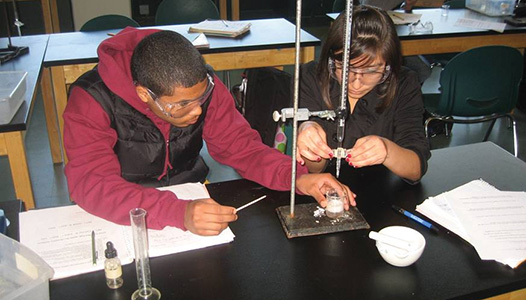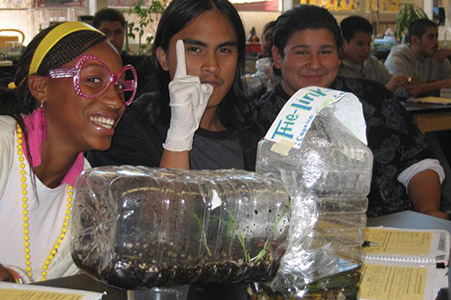A Bay Area science teacher was honored last month by the EPA and the White House Council on Environmental Quality for shaping a curriculum that makes learning about the environment fun for students.

Powell’s field trips are usually followed by in-lab analysis, where students sharpen their critical thinking and reporting skills. Photo by Lance Powell
By Bill Picture
Published: August, 2015
A Bay Area science teacher was honored last month by the EPA and the White House Council on Environmental Quality for shaping a curriculum that makes learning about the environment fun for students. James Lance Powell, who teaches eco-oriented science classes at Menlo-Atherton High School in San Mateo County, received a Presidential Innovation Award for Environmental Education (PIAEE) at a ceremony held at the White House.
PIAEE awards are given to environmental educators whose lesson plans employ an innovative, hands-on approach to learning. In addition to the award, Powell will receive $2,500 for continuing education, while his school will receive $2,500 to support its environmental education program.
UC system not so keen on green
While sustainability has been integrated into many high school science programs across the country, most classes with a narrow focus on the environment are still not accredited by the University of California system. “Only AP environmental science classes are accredited,” Powell said. “It’s surprising, right. I think the problem is that environmental science is often confused with environmental studies, which is less rooted in science.”
In order to share his own passion for the environment with students and have it count for them (toward college credit), Powell created “environmental analysis through chemistry,” a traditional chemistry class with a fun eco-bent that earned a UC stamp of approval.
“I look at it as two victories,” he said. “First, I feel it helped legitimize environmental science. Second, it helped take a subject that most students find really confusing—chemistry—and made it relatable and relevant.”
“I mean, chemistry stumps everyone, right,” Powell said. “Not only that, I remember studying chemistry and thinking, ‘Why do we need to know this?’ But when you apply it to the world you live in, it suddenly makes more sense.”
Powell’s lesson plans regularly take students out of the classroom and into the field, where they experience chemistry in action in the world around them. The students then return to the classroom for good old-fashioned lab analysis and scientific reporting. “One of the things we do is, I have my students collect storm water samples in their own neighborhood, and then bring the samples in for analysis.”
Powell says his students are often surprised to find high concentrations of harmful chemicals and metals in the samples they collect. “In one case, the concentration of nitrates was 27 times what is considered safe,” he said. “And the fact that the sample literally came from a student’s own backyard prompted them to start asking questions: ‘What is a nitrate?’ ‘What is its impact on the environment, and on me?’ ‘How did it get there?’ As an educator, I feel that’s my job in a nutshell—to get students asking those questions.”
Furthermore, Powell says his lessons regularly spark healthy in-class discussions about sustainability and environmental justice. “They’re really interested in the injustices,” he said. “A lot of situations that adults barely bat an eyelash at really fire my students up. And they go, ‘Why is this happening?’ That’s what we need to fuel change—that passion, to help us find the solutions to environmental issues.”
Children and the future
“To tackle future ecological challenges, it is critical to instill a sense of environmental protection in our new generation of students,” said EPA Region 9 Administrator Jared Blumenfeld in a written statement.
Powell couldn’t agree more. “They’ve got an inherent natural interest in the environment and environmental issue,” he said. “The education system needs to find more ways to engage that interest early on, and hook them in. Otherwise, the students lose it; and educators like myself find ourselves having to be salesmen, trying to convince students that this stuff is cool, and that it’s important.”
Powell says an unstoked flame of eco-curiosity in a student can result in what he jokingly calls “nature deficiency disorder.” “Or video-game-itis,” he said. “When we go on these field trips, most of the time we’re just a few miles from school, and it’s like they’ve never been outside before. Trudging around in a creek bed is so foreign to them that you’d think we were in the backwoods of Alaska. It’s like an Indiana Jones adventure or something.”
Powell says some schools have begun teaching environmental science to ninth-graders, as ninth-grade classes typically don’t count toward college credit. But he’d like to see the environment on schools’ curricula much, much earlier.
“I read someplace that a child’s enthusiasm for science begins to wane in the fifth grade,” he said. “If you think about it, that makes sense. Little kids are just naturally interested in being outside, going on nature hikes and looking for bugs. So if that’s true, we need to start teaching them about the environment way before high school. The earlier the better, in fact. We need to keep their curiosity fire aflame.”
Doing so, Powell said, will have benefits beyond just producing science-savvy adults. “The critical thinking skills they develop from science will help them get through school, and get through life,” he said.
He believes a more robust science background, and one that includes more environmental science, will also help better prepare young people for the tough job market that awaits them, by helping them to recognize opportunities and seize upon them. While the green tech boom is partly the result of the Bay Area’s healthy entrepreneurial spirit, science is its foundation. Every green tech idea started with someone (or a group of people) recognizing a problem, and then dreaming up a way to solve it.
“Sometimes I see that light bulb go off in a student’s head, and I get really excited,” Powell said. “The truth is, any one of my students could be the one to come up with the next million-dollar idea.”

Powell says the goal in creating his “environmental analysis through chemistry” class was to demystify chemistry and make it fun. The class is one of the few non-Advanced Placement science classes with an environmental focus to receive accreditation from the University of California system. Photo by Lance Powell

